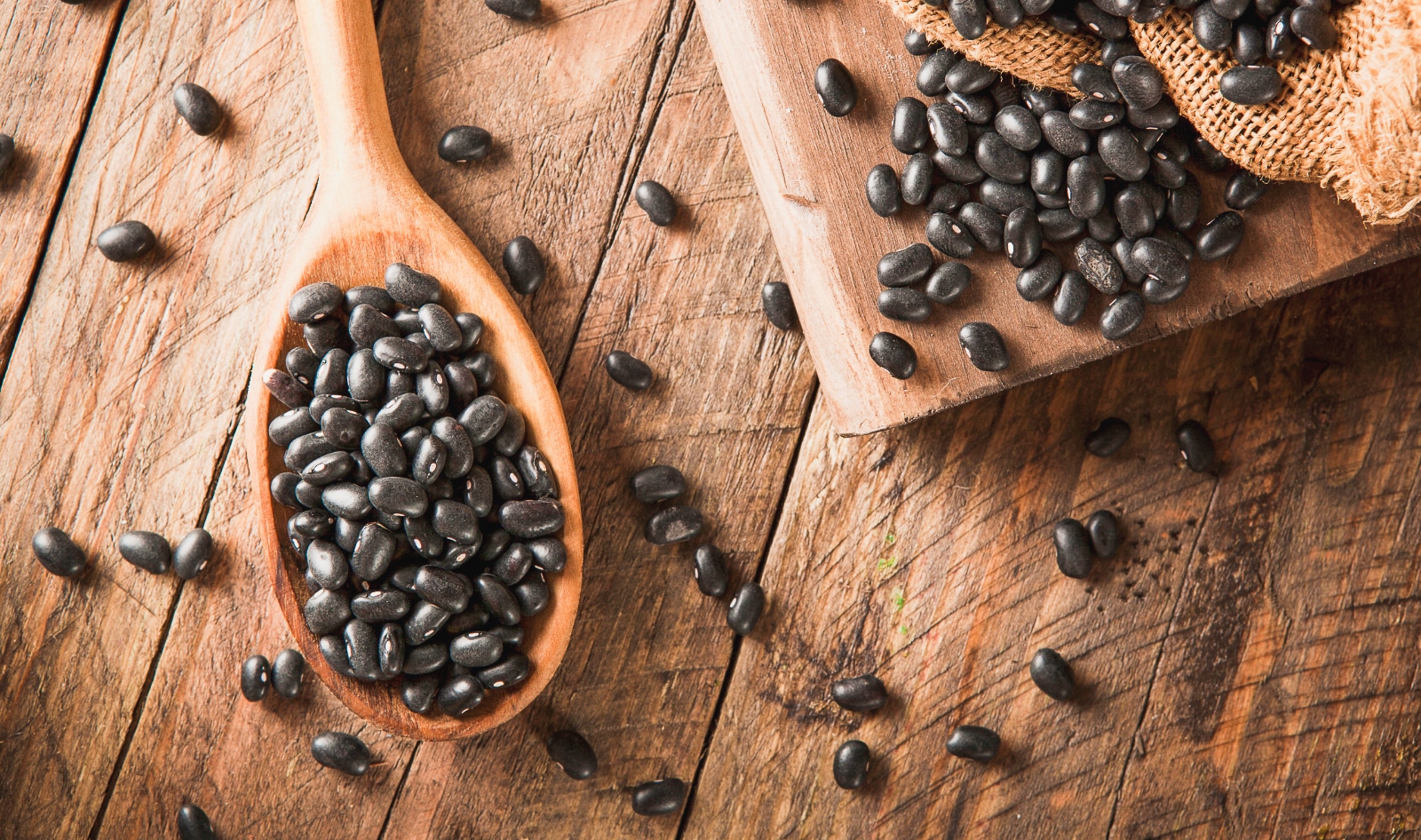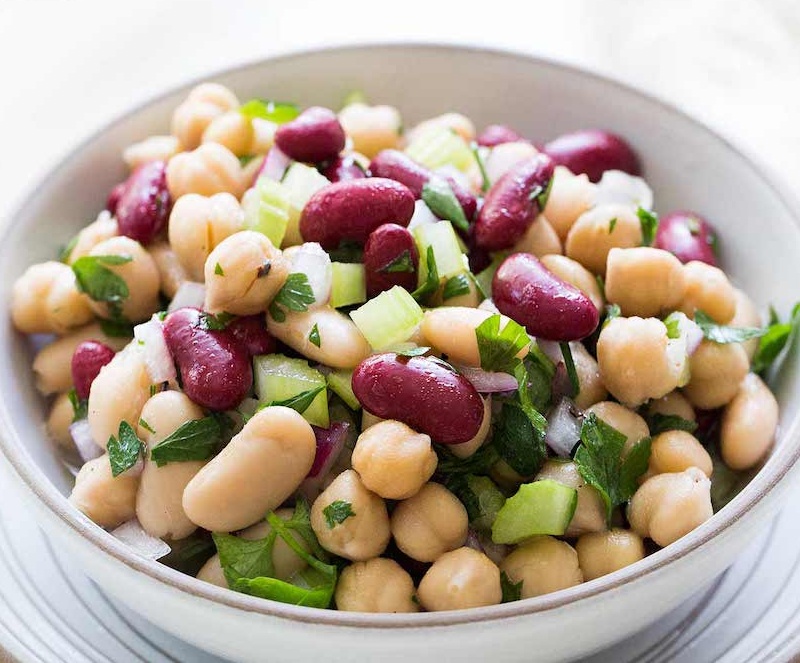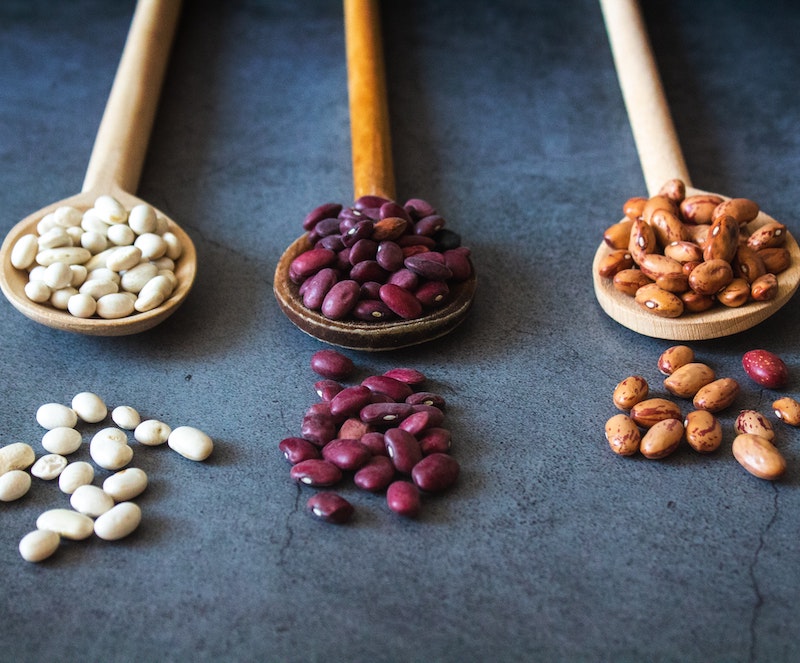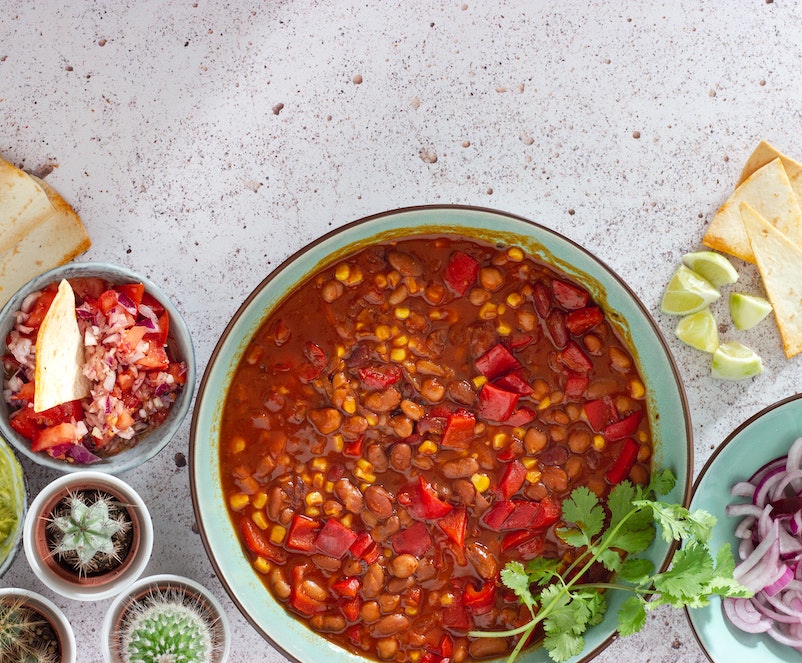
Beans are the original vegan protein. They existed before the über-realistic plant-based meats and provided sustenance before seitan. Technically, beans even pre-date tofu. With up to nine grams of plant-based protein per half-cup serving and very little fat, beans are an efficient, healthy, and tasty way to meet your daily protein needs. From soybeans to chickpeas and black beans to pinto, here is everything you need to know about this high-protein plant-based powerhouse—plus seven bean recipes to make you drool.
What are beans?
Beans are a member of the pulse family. Pulses are the edible seeds of legumes that grow inside pods. While you may be familiar with a handful of beans varietals such as black, garbanzo, pinto, and kidney, the category encompasses over 400 types that are eaten around the world. Beans are universal not only for their abundance but also for their accessibility, affordability, and superior nutritional profile. Rice and beans may be struggle food, but there’s a reason so many gravitate to this humble dish. It’s filling, it’s nutritious, and it’s cheap. Given the right preparation and a few seasonings, rice and beans can also be delicious and satifying. Beans are basic, but also infinitely versatile.

Health benefits of beans
The protein in beans varies depending on the type of bean, but most contain 21- to 25-percent protein by weight, or anywhere from five to nine grams per half-cup serving, cooked. The same half-cup serving provides about 100 to 120 calories, less than three grams of unsaturated (healthy) fat, up to six grams of fiber, and a significant amount of vitamins and minerals including folate, potassium, iron, manganese, calcium, and magnesium. As a whole, plant-based food, beans are also cholesterol-free. Beans offer satiety in a nutrient-dense package, and while they may not contain as much protein per serving as some animal-based foods, they deliver nutrition without the health implications that come with meat and dairy (inflammation, cholesterol, hormones, and saturated and trans fats).
How to cook beans
It’s been said that dry beans are more affordable than canned beans, which is true, but not by much. In the US, canned beans can typically be found for 99 cents or less depending on the brand and grocer. Many opt to sacrifice a few cents for the sake of time and convenience—there’s nothing easier than heating up a can of cooked black beans and tossing on a salad or smearing refried pintos on a tortilla. However, dry beans are marginally less expensive and you can typically impart more flavor into the beans when cooked from scratch. Here’s how to prepare a perfect pot of beans.
To improve digestibility and dramatically cut down on cooking time, experts recommend soaking dry beans for eight hours. Once drained, drop the beans into a pot and cover with about two finger widths of water, then bring to a boil. Reduce the heat to a simmer and continue cooking for 30 to 40 more minutes. Season to taste and continue simmering until a few tester beans are tender or can easily be mashed with a fork. The time may vary, but the cooking time should not exceed two hours total—just be sure to test every half hour to ensure your beans don’t turn to mush.

Highest protein beans
Incorporating any kind of bean into your diet is a plus, but some are higher in protein than others. Here are the highest protein beans you can buy. Note: protein content is based on a standard half-cup serving, which means if you’re opting for double beans at Chipotle (we all do that, right?), double the amount.
1 Cannellini beans
Also called navy beans, these mild white beans contain eight grams of protein. They’re also high in manganese—an essential nutrient that helps regulate everything from metabolism to brain function. They play well with other ingredients and add sustenance to stews and texture to salads.
2 Great Northern beans
Similar in taste and texture to cannellini beans, this slightly larger white bean variety packs in nine grams of protein. They also contain more potassium than a medium banana—an electrolyte that supports proper nerve function (translation: less muscle cramping!). Try blending these beans into a creamy pizza sauce by adding a bit of garlic, sage, and vegetable broth to the mix.
3 Edamame
This go-to appetizer is full of plant-based protein. These immature soybeans provide just over eight grams of protein and a solid amount of iron, magnesium, and even some calcium. Go ahead and snack away—you could hit your protein needs before the main course arrives.
4 Black beans
The choice between black and pinto beans is always tough. While similar in protein content, black beans edge out pinto by a few tenths of a gram. Black beans provide 7.6 grams of protein while pintos contain 7.2 grams. Fun fact: pintos may be the default choice for refried beans, but you can find vegan refried black beans at most supermarkets.
5 Pinto beans
Pinto bean loyalists are doing just fine. With a little over seven grams of protein per serving, go ahead and enjoy your pinto bean burritos, seven-layer refried bean dip, and basic beans and rice topped liberally with salsa and guac.
6 Kidney beans
Kidney beans are right on par with pinto beans in terms of protein—both contain 7.2 grams. Opt for these deep red beans if you’re looking for a protein and iron one-two punch. Kidney beans provide a whopping 21 percent of the daily recommended iron. No standard vegan chili is complete without a healthy dose of kidney beans.
7 Chickpeas
As much as we love hummus, enjoying chickpeas as they come is a more efficient way to source your protein. Chickpeas—or garbanzos—provide just over six grams of protein. Two tablespoons of hummus only clocks in at two grams. Toss them in soups, over salads, or make nutrient-dense baked goods by blending in a handful of garbanzos into the batter. Don’t believe us? Try this recipe for Chocolate Chunk Blondies.

High protein vegan recipes with beans
Providing nutrients is one thing, but we want our beans to be appetizing as well as nourishing. Here are seven simple recipes to transform basic beans into craveable meals.
1 Speedy Breakfast Hash with Potatoes and Black Beans
You’ll need all the protein you can get to lift this monstrous cast iron skillet full of seasoned home fries, beans, and veggies. The entire thing is simply seasoned with a jar of your favorite salsa—meaning you can skip the complex array of spices and simply dump and stir. This is our kind of cooking.
Get the recipe
2 Vegan Butter Chickpea Curry
Why wait for delivery when you can craft your own curry at home? This comforting main meal is layered with flavor in the form of ginger, garlic, curry paste, coconut milk, and dried chili flakes. A can of chickpeas adds both texture and protein. Soak up the stew by serving over fluffy rice or with a side of vegan naan or roti.
Get the recipe
3 Vegan White Bean and Seitan Pozole
This homey Mexican stew provides plant-based protein in two forms: white beans and seitan. Both are exceptionally high in protein while also adding the meaty chew that’s characteristic of this dish. Make a large batch and freeze any leftovers for a quick and wholesome meal.
Get the recipe
4 Vegan Tahini Caesar Salad with Smoked Chickpeas
The classic Caesar salad is great, but it’s often lacking in nutritional value. If we’re eating salad, we want it to not only taste fantastic but check off a few nutrient boxes. Adding a handful of crunchy seasoned chickpeas helps to round out the dish by providing a boost of protein and fiber to transform this starter into a satisfying entrée.
Get the recipe
5 Vegan Chili and Cornchip Pie
At what point does a dish become a casserole? Technically speaking, it’s when you cook it in a casserole dish. This protein-packed chili will feed a crowd, and with the addition of crunchy corn chips, it’s sure to please. Pro tip: add a layer of dairy-free cheese to gild the lily in the most delicious way possible.
Get the recipe
6 Vegan Freezer-Friendly Breakfast Burritos
Meal prep becomes infinitely easier once you realize you can freeze pre-made burritos. These humble wraps come together quickly and provide 20 grams of vegan protein per serving. The filling is made with a veggie-infused tofu scramble and seasoned black beans for a Southwest-inspired burrito perfect for breakfast, lunch, or dinner.
Get the recipe
7 Vegan Chickpea Banana Bread
We promise, you really can’t detect the beans in this quick bread recipe. This homey loaf is made with a blend of chickpea and whole wheat flour—both of which contain more protein than your standard white flour. To bump up the protein, slather a warm, thick slice with your favorite nut butter. Getting your protein never tasted so sweet.
Get the recipe
For more on vegan health and nutrition, read:
10 High-Protein Vegan Recipes
How to Get Iron on a Vegan Diet
How to Get Calcium on a Vegan Diet
This post was originally published on VegNews.com.